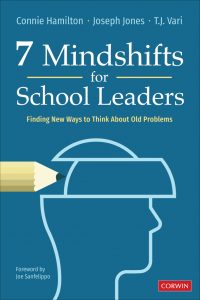#SH302: Leading for Energy and Enthusiasm
Realizing Great Advice
Susan is in her fourth year as principal of Smithfield High. Although she feels that there is a great deal of work that remains to be done, she is excited about the school’s progress so far. All data points show improvement, morale is high, parent involvement is growing, and there is a noticeable positive vibe throughout the school, among staff and students. After a great teacher observation, Susan enters her office, sits back in her chair and reminisces on her first year, which she would characterize as extremely difficult.
She recalls her superintendent offering sage advice after she accepted the position: “Susan, we have the utmost faith in you. We believe that you have all the knowledge, skills, and abilities to turn this school around. This school was once the pride of our town and it needs to be, once again, a beacon within the community.” He then took a deep breath and said, “I don’t believe in micromanaging or even giving too much advice. But I will tell you three important truths that I’ve always led by. One, people don’t care how much you know until they know how much you care. Two, measure twice and cut once. And three, light is the task where many share the toil.”
Susan’s superintendent, originally a tradesman and vocational teacher, valued hard work, determination, and the power of strong collaboration. He then continued, “great leaders know that success is not random and change that we can control is precise and deliberate. Take time to truly learn the needs of the school, dissect the issues, build your team. When it’s clear, Susan, you’ll know when to take massive decisive action.”
Recalling those words of wisdom, Susan smiled and remembered how his advice and encouragement originally confused her. At the time, Susan was a seasoned administrator with eight years of successful experience as an assistant principal in two different and challenging Title I schools. She already had plans for Smithfield High and was confident that she could turn the school around. However, the superintendent’s words made her rethink her entry plan and she even reconsidered some initial ideas she wanted to implement. In fact, the superintendent’s words led her to a unique epiphany that her success would rely on her ability to blend the technical, skillful, even surgical efforts, with the emotional, passionate, and caring needs of the school.
A Marriage Between Hard and Soft Leadership Skills
Susan understood that knowing what needed to be done must be fueled by a common cause, common goals, and common desires. These combined efforts create enthusiasm, motivation, and ultimately energy. People need to be excited about what they are working towards and great leaders know how to build that enthusiasm toward student achievement.
Susan’s first year was difficult. The school was performing below the state average on the state assessment, student daily attendance was poor, and staff turnover was making any lasting change impossible. What made things even more difficult was that Susan was the fourth principal the school had seen in seven years. Staff had learned to rely more on themselves than any appointed leader. All of these compounding variables made resurrecting Smithfield a daunting task. However, Susan knew the ingredients of a successful schools, and she took note of what was done in those systems, and she had a calling to make that happen at Smithfield.
As a result, she set a very clear course of action that combined her previous success with the simple rules laid out by her superintendent. One, she established a tone of decency with care and compassion at the core that were married to high expectations for every staff member and every student. She knew she could not bulldoze or strategize her way into the hearts and minds of those she wanted to lead. Two, she committed to truly learning all the issues facing the school to blend the best tried and true practices with the unique needs of Smithfield. Three, she empowered the staff through strong collaboration and teamwork that was grounded in accountability. So, what was the result? Within three years the energy, enthusiasm, and excitement within the school was palpable. In fact, you could feel it after her first year.
Building a Culture of Care, Grounded in High Expectations
Leadership Assumption: Staff and students know you care.
High energy, successfully thriving environments are built on the knowledge, faith, and trust that the leader cares. This care manifests itself in all actions and decisions that become the foundation for trust. Susan entered a difficult situation that was exacerbated by high turnover for both teachers and administrators. Susan’s efforts would have fallen short if she simply didn’t take time to demonstrate care for students and teachers. As John Maxwell states, “Leadership is not about titles, positions or flowcharts. It is about one life influencing another.” And for Susan to ever begin influencing anyone, she needed to develop trust by establishing a caring environment.
To develop trust, Susan utilized two profound strategies that are too often underused and overlooked, she became curious and she listened. She demonstrated genuine curiosity about everything and everyone related to the school and she listened closely to the whole community. It almost sounds trite, but this allowed her to be receptive to new information and not presumptuous about what changes needed to be made. As a result, not only did she gain incredible insight into the needs of the school, but she also started to develop strong relationships with those who needed her leadership most.
The challenge is that a caring environment is not enough. A critical element that Susan combined with caring deeply was her high expectations. As Susan listened and gained insight, she found opportunities to paint a picture of what Smithfield could become and the hard work that was before them. These were dire circumstances and Susan took time and effort to ensure everyone was clear on where the school was heading and what it would take to get there, which led her to her next step, executing change.
Technical Tip: Building trust has neurological implications so what Susan did was quite scientific even if it sounds like a soft skill. Susan was exhibiting 2 of the 8 “management behaviors” identified by Paul Zak, founding director of the Center for Neuroeconomics Studies. She was inducing a challenge for her team at the same time that she was intentionally building relationships by expressing interest. She improved the energy in her school, and it wasn’t an accident.
Executing Change, Grounded in Specific Needs
Leadership Assumption: Best practices are one size fits all.
Susan knew that success is not canned and what works in one environment may not work in another. The key wasn’t in what worked in her other schools, but would work at Smithfield. She also didn’t want to make the mistake of simply initiating changes that the school community did not buy into. The last thing she wanted was staff to think that she would be another short-term principal with a host of ideas and initiatives that would be implemented by a leader that did not stick around to see the results. Knowing the delicate nature of implementing change, Susan ensured the changes and initiatives to be implemented were sound best practices that would be best for Smithfield in the long-term.
The notion of measuring twice and cutting once ensures accuracy, decreases waste, and ultimately leads to the desired result or product. Susan knew that her changes had to work for her own success, but ultimately for the school’s sustainable improvement. So, when Susan thought of how to increase the reading and math scores that were in the bottom quartile within the state, she knew a canned program wouldn’t be enough for any real success. It is people, not programs, that are the impetus for initiating and sustaining lasting change.
The challenge is blending the idea, initiative, or strategy into the fabric of the school. Fortunately for Susan, her early conversations introduced her to dynamic teachers who she ultimately relied on to implement the various initiatives. For example, Susan introduced a school-wide literacy focus. The reality was that Susan’s predecessor also rolled out a literacy plan, so the idea of literacy across the curriculum was nothing new to Smithfield. However, Susan’s literacy plan was built on the teachers not the program. She also chose two teachers to lead the charge, garnering the support of the whole staff, and ensuring fidelity of implementation. They used data to measure twice, and they used teacher-led strategies to cut once. This approach complemented her third strategy, which is truly the fuel for an energized environment.
Technical Tip: “One of the most critical tasks for leaders of change is communicating a sense of urgency. A sense of urgency keeps positive energy flowing and increases productivity” (Bunker & Wakfield, 2008). But, the energy from urgency has to be balanced with “realistic patience.” Susan knew what the data said about the school’s performance, and she used that to motivate change. With that said, there’s a paradox that great leaders recognize when it comes to change. She also supported the staff as the focus and not a new program, which showed that she was willing to be patient for the sake of sustaining the long-term change that comes when people are expected to make the difference versus expecting a new program or policy to drive the needed changes.
Empowering People, Grounded in Accountability
Leadership Assumption: Leaders know how to empower their employees.
Great principals empower their teachers, develop strong leadership teams, create a definitive action plan through collaboration, and then, most importantly, get out of the way!
Successful leaders know that it cannot be done alone and high functioning teams are the answer (Mankins & Garton, 2017). Great teams ensure that the leader’s vision permeates every layer of the school. Schools that possess positive energy have dynamic teams working in concert with the leader and with one another.
The beauty of empowerment is how it manifests itself among people. As former Starbucks CEO Howard Schultz explains: “People want guidance, not rhetoric; they need to know what the plan of action is and how it will be implemented. They want to be given responsibility to help solve the problem and the authority to act on it.” Empowerment enables individuals to be a part of the process and live out the successes and failures of the organization. Susan understood that despite the vast teacher turnover there were still committed teachers at Smithfield who were passionate about their work, their students, and the school’s success.
The challenge Susan faced was ensuring the teams she developed were clear on what they were working towards and how they were held accountable. The goal was to weave accountability both internally and externally. Internally among team members and externally regarding specific benchmarks and metrics that the school needed to meet. Empowering teachers creates synergy, and in order for success to ensue, synergy is paramount. Positive energy is formed through connectedness and the bonds that people have with one another when they experience a cycle of excellence, progress, and momentum (Hallowell, 2011). This energy is the result of people feeling a strong tie to their work, their colleagues, and the natural outcomes of care, deliberateness, and teamwork.
Technical Tip: “The foundation of every great team is a direction that energizes, orients, and engages its members” (Haas & Mortensen, 2016). Susan used a 4-D team approach for each team she put together. She created a compelling direction with strong goals, she maximized the diversity among the team members for a strong structure, she provided a supportive context with resources and a budget, and she created a common identity and solid understanding so that teams had a shared mindset (Haas & Mortensen, 2016). Susan’s teams were empowered because she knew the secrets to assembling them and the ultimate outcome was that each team infused energy into the whole school in a unique way.
It All Adds Up to Energy
Creating an environment with a noticeable positive energy is challenging. Filling any and all negative voids with positivity and enthusiasm is a result of true leadership (Gordon, 2007). Susan faced an uphill battle that required hard work, the willingness to build relationships, understanding the true issues, and relying on others to be successful. These are the ingredients for success and developing an authentic environment. Genuine positive energy in schools is not the result of one thing or artificial rewards and achievements. Energetic successful cultures stem from a concerted effort among a committed staff to teach and learn at a high level every day. Smithfield High continues to improve and strive for success with many areas that still need to be improved, but when you walk through the doors, there is no doubt that special things are happening.
TheSchoolHouse302 is about getting to simple and maximizing effective research-based strategies that empower individuals to lead better and grow faster.
Let us know what you think of this #SH302 post with a like, follow, or comment.
Bunker, K. & Wakefield, M. (2008). The balance needed to lead change. Harvard Business Review.
Gordon, J. (2007). The energy bus: 10 rules to fuel your life, work, and team with positive energy. New Jersey: Wiley.
Haas, M. & Mortensen, M. (2016). The secrets of great teamwork. Harvard Business Review.
Mankins, M. & Garton, E. (2017). Time, talent, energy: Overcome organizational drag & unleash you team’s productive power. Boston: Bain & Company, Inc.
Maxwell, J. C. (2011). The five levels of leadership: Proven steps to maximize your potential. New York: Hachette Book Group.
Schultz, H., & Yang, D. J. (2014). Pour your heart into it: How Starbucks built a company one cup at a time. New York: Hachette Book Group.
Zak, P. (2017). The neuroscience of trust. Harvard Business Review.



 7 Mindshifts for School Leaders: Finding New Ways to Think About Old Problems.
7 Mindshifts for School Leaders: Finding New Ways to Think About Old Problems. 


